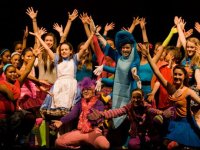The Greatest Shows on Earth: The Case for Arts Education and Support
Your content has been saved!
Go to My Saved Content.Last spring, I saw one of the happiest and the saddest sights of my life.
Let's start with the happy. A social worker friend invited me to go with her to a youth performance at the Wang Theater, one of the aged performance venues in Boston's tiny theater district.
I'm not proud to admit this, but as we took our seats in the fourth row, I was expecting a kind of large-theater version of another school musical.
Onstage Magic
The curtain lifted to a team of smirky youngsters wheeling a chair onto center stage. Then they returned backstage to go fetch some grown-ups. Using elaborate, Vaudevillian gestures, the teens dragged the staid, reluctant grownups onstage by the hand. "Just one try," they said. "You gotta try our magic chair." So the adult sat. The chair lit up and gyrated. The music boomed as, one by one, each Baby Boomer caught the hip-hop bug and jounced and danced in that chair.
This annual gala performance is a collaboration between Express Yourself, a Massachusetts program that immerses young people in the creative world of music, dance and visual arts, and 150 students from 17 publicly funded community education programs and therapeutic residential homes located across the state. All of the participant youth are "at risk," and most of their specialized education and therapeutic programs are funded by the state. Who was the one of the first reluctant "converts" to sit in the magic hip-hop chair? You guessed it -- the governmental department head!
For the entire year between these annual performances, the students get to work with professional artists, choreographers, singers and musicians. According to the kids' individual interests or skills, they choose between set design and building, visual arts, dancing, singing or instrumental music -- or a combination of all.
After this first act, the performance revved up even more as the stage kids got us all on our feet. I mean, picture it! It's an ordinary Wednesday, and here are over 3,000 buttoned-up New Englanders (who gave us that rap anyway?) fist-pumping and hip-hopping along to the kids' pitch-perfect performances in this 88-year-old theater.
The skits made us laugh. The colorful, constantly changing stage sets made us gasp. The dancers and drummers made us clap and jump and groove. The choral singing brought tears to our eyes.
From that fourth row seat, I studied every one of those 150 beaming faces -- 150 testimonies to what happens when we expose our kids to the arts.
Empty Seats
And now comes the sad part of this story. After the show, my friend and I waited around for the youth to come off stage. As we hugged and congratulated, a few of the older teens tried that "hey, it was nothing" shtick. Seriously? None of us adults was going to let them get away with blasé teenage stuff.
And then I saw her -- a young girl standing there with the tears tracking down her cheeks. I looked into the saddest eyes in the world. Less than 20 minutes earlier, this girl was among those smiling, performing youth on that theater stage.
"What’s wrong?" I whispered to my friend.
"Her parents said they'd come, but they didn't show."
So in this young girl's mind, all that choreography, all those stage smiles were for naught.
A few weeks later, when I told this story to a friend who teaches high school, she assured me that this parental no-show stunt is not unusual. The Saturday or after-school sports events? They're packed. But the school's poetry slams, often full of those so-called alternative, non-jock kids? My teacher friend reported that some parents have never come to watch their kids perform their poetry, never sat to listen to what's in their kids' hearts.
Equally, as part of my own double life as a creative writer and teacher, I used to be among the instructors in a bargain-basement-priced conference for young writers. This two-day conference brought private and public school students together with local published authors and poets.
I always expected the administrators would have to wait-list applicants. But even though the $85 fee included three daily meals, we never filled those seats. And if the fee had been a problem, I know that I -- and I'm sure the other writer mentors -- would have gladly paid or supplemented.
Oh, yes, there are lessons here.
The Greatest Gift
When I think of my own life, I feel guiltiest about all those times when, instead of showing up, I made some lame excuse. I sent a sympathy card instead of going to the wake. I sent a last-minute email saying that I'd love to come to the book launch, but gee, work had me exhausted. I sat by a hospital bed where, instead of holding that hand on the white sheet, I staged my own Vaudevillian performance of diversionary bedside small talk.
Equally, when I replay my own gallery of youthful hurts and tears, the most indelibly wounding are not from words or actions, but from an adult's thoughtless absence.
So as we plan for or justify each year's school funding, let's scrounge up those dollars to give every youth a chance to audition, create, perform, paint, sing or dance. Let's let them discover what they can really do. And then, let's leave our TVs and personal electronic devices to go see them do it -- in person, fully present and with heartfelt applause.
